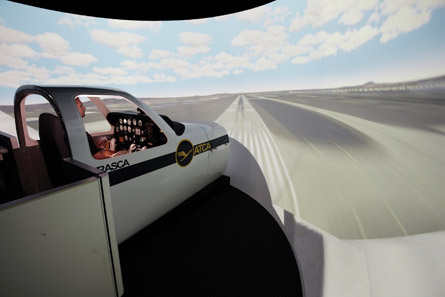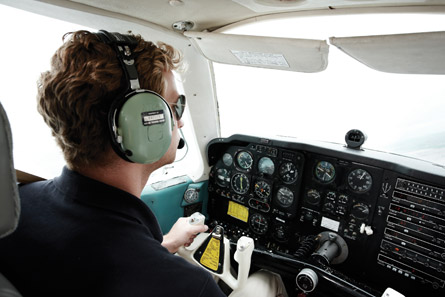European airlines differ in their approaches to managing flightcrew, taking varying degrees of active involvement in initial training. What seems to unite them, however, is that they tactically plan their demand for cockpit personnel only a few years in advance. There is no clear, long-term industry standard on how the next pilot generation will be trained to command the large fleet in the manufacturers' orderbooks.
Boeing forecasts 92,500 pilots will be required in Europe during the next 20 years. Asia Pacific will need 183,200, with China accounting for 72,200 alone. North America is expected to require 82,800 pilots, Latin America 41,200, the Middle East 36,600, Africa 14,300, and the CIS 9,900 until 2030. These figures sum to about 460,000 in total.
 |
|---|
© Lufthansa Flight Training Lufthansa trains cadets in Arizona |
While the aircraft backlog continues to increase in spite of shorter and more erratic economic cycles, there is widespread concern over whether pilot-training academies have kept pace with airline growth and can deliver enough new flightcrew with the required capabilities. British Airways changed its pilot recruitment strategy last August after it foresaw a potential flightcrew shortage. The UK carrier wants to employ about 800 pilots during the next five years. While it needs about 100 new employees per year to maintain its approximately 3,200-strong cockpit workforce, BA wants to employ 150 flightcrew members every year for growth. Half of these recruits should come via direct entry from other airlines and the military, while the other half will be career starters from ab initio level. This is BA's biggest pilot recruitment initiative in more than a decade.
The main difference lies in the renewed interest in ab initio students. BA employed fresh air transport pilot licence (ATPL) holders before, but those graduates had undertaken and financed their training independently and were hired from the open market after qualification. Self-funded training has become the main route into a cockpit for aspiring pilots since 2001, says Anthony Petteford, managing director for ab initio training at Oxford Aviation Academy (OAA) in the UK.
RETAIL TRAINING
Airlines, including BA, previously pre-financed the training of a limited number of ab initio students after they had undergone an initial selection process, with the young pilots repaying the fees later during employment. This changed, however, with the aviation downturn after 9/11 and the concurrent rise of budget carriers such as EasyJet and Ryanair, which had always drawn cockpit personnel from the open pilot market. Petteford points out that the shift to this "retail" training model has moved control over cadet enrolment numbers from airlines to individuals.
BA still does not pay for the flight training in three selected academies, but now helps its students secure the required funding by guaranteeing a bank loan. Access to credit has become a main hurdle for pilot aspirants because of the financial crises since 2008, threatening to turn the profession into a career option mainly for children from sufficiently affluent backgrounds. BA worked with banks to devise a loan scheme because it feared the pool of applicants made of the right stuff was becoming too limited.
BA sister carrier Iberia is also recruiting a large number of flightcrew, although this will only be for its planned low-cost subsidiary Iberia Express, due to begin operations with four Airbus A320s at the end of March, which will gradually take over the parent's short- and medium-haul network. While 125 pilots are needed for the start-up phase, this is set to increase as the new airline is scheduled to have 13 aircraft by year-end and 40 by 2015. Iberia has traditionally recruited qualified pilots from a military or civilian background.
A number of flightcrew will transfer to Iberia Express from the parent carrier, which will concentrate exclusively on long-haul flights. The latter's approximately 1,500-strong cockpit workforce will gradually move up the ranks and convert to the A330/A340 fleet as senior flightcrew members retire. However, Iberia has no plans to recruit new pilots for the mainline operations. Whether it will be possible for Iberia Express flightcrew to transfer to the parent carrier is as yet unclear.
Lufthansa expects to take on about 300 new pilots this year. The German airline mainly recruits ab initio cadets who learn their trade at the in-house training campuses in Bremen and Goodyear, Arizona. Only if demand exceeds the available supply of career starters does the airline fall back on direct-entry pilots.
SPONSORSHIP
Unlike many of its European competitors, Lufthansa still sponsors the training of its cockpit staff, giving it complete control over the training quantity and quality. The selected students receive an interest-free loan from the airline of €60,000 ($77,000) to contribute to the training, which costs about €300,000 in total, says Lufthansa. The cadets are only responsible for their housing and living costs during the two-year training programme, and repay the loan later during employment.
Lufthansa's two Alpine subsidiaries - Austrian Airlines and Swiss International Air Lines - pursue the same paternalistic model. The former has stopped pilot recruitment for the time being because of restructuring. However, Swiss plans to employ 400 to 500 new pilots during the next five years, while about 100 are due to retire. The Swiss carrier has capacity to qualify up to 100 ab initio students a year. This is done partly in-house and at its partner academies Flugschule Grenchen, near Berne, and FlightSafety in Vero Beach, Florida. Any demand beyond that will need to be satisfied via direct-entry pilots or by utilising training capacity of the parent group.
 |
|---|
© Lufthansa Flight Training Unlike many European airlines, Lufthansa still sponsors the training of its cockpit staff |
Ryanair's pilot recruitment strategy, on the other hand, is firmly based on the retail model and on aspirants taking their own initiative to earn their wings. Since the training is self-sponsored, the financial details are "not a question for Ryanair", says the Irish budget carrier.
As with other airlines, the students even pay for their type rating at the company's simulator centre at East Midlands Airport, UK, or CAE in Amsterdam. Free line training is provided to students "subject to certain conditions". Nevertheless, Ryanair says it has a backlog of "several thousand" applications from ATPL holders. Between April 2012 and April 2013, the airline plans to take on between 400 and 450 pilots.
Petteford does not share the concern that the flight-training industry will be unable to supply required future pilot volumes. He says that while statistics have been predicting deficits between pilot demand and training capacity for almost two decades, the training industry has, so far, been able to provide the necessary pilots. "I have been in this business for 15 years, and I have never been in a situation where I could not supply [from the graduate pool]." He adds that, despite the financial crisis and associated credit access difficulties, application numbers for the academy's European airline pilot training programme have not fluctuated significantly during the past years. OAA qualifies 250 to 300 ATPL students a year and could easily increase capacity to 400, if there was sufficient market demand.
What is crucial, however, is that airlines support airline pilot training programmes at flight academies and continue to recruit their graduates, says Petteford. "My fear is that the day when airlines completely abdicate their responsibility of mentoring students [is the day when] we might see a different story."
PARTNERSHIPS
OAA is one of three pilot schools which BA is partnered with for its ab initio training programme. Similar co-operations are in place with Aer Lingus, EasyJet and Flybe. The latter two have even established multi-crew pilot (MPL) licence programmes at the academy. The new airline pilot-training philosophy has shifted the balance from single pilots flying light aircraft to more airline-typical operations in simulators.
Not only is this type more relevant to modern airline operations in highly automated flightdecks, says Petteford, it would also be a way to increase training capacity because it is less dependent on external infrastructure, such as free airspace and adequately equipped airports for instrument approaches. So far, however, only about 10% of OAA's trainees are enrolled in MPL courses.
Such programmes can only be established in partnership with airlines because the training is tailored around the latter's individual standard operating procedures. If this is the way forward, however, it will require active participation and long-term commitment from the airlines.
Source: Flight International























